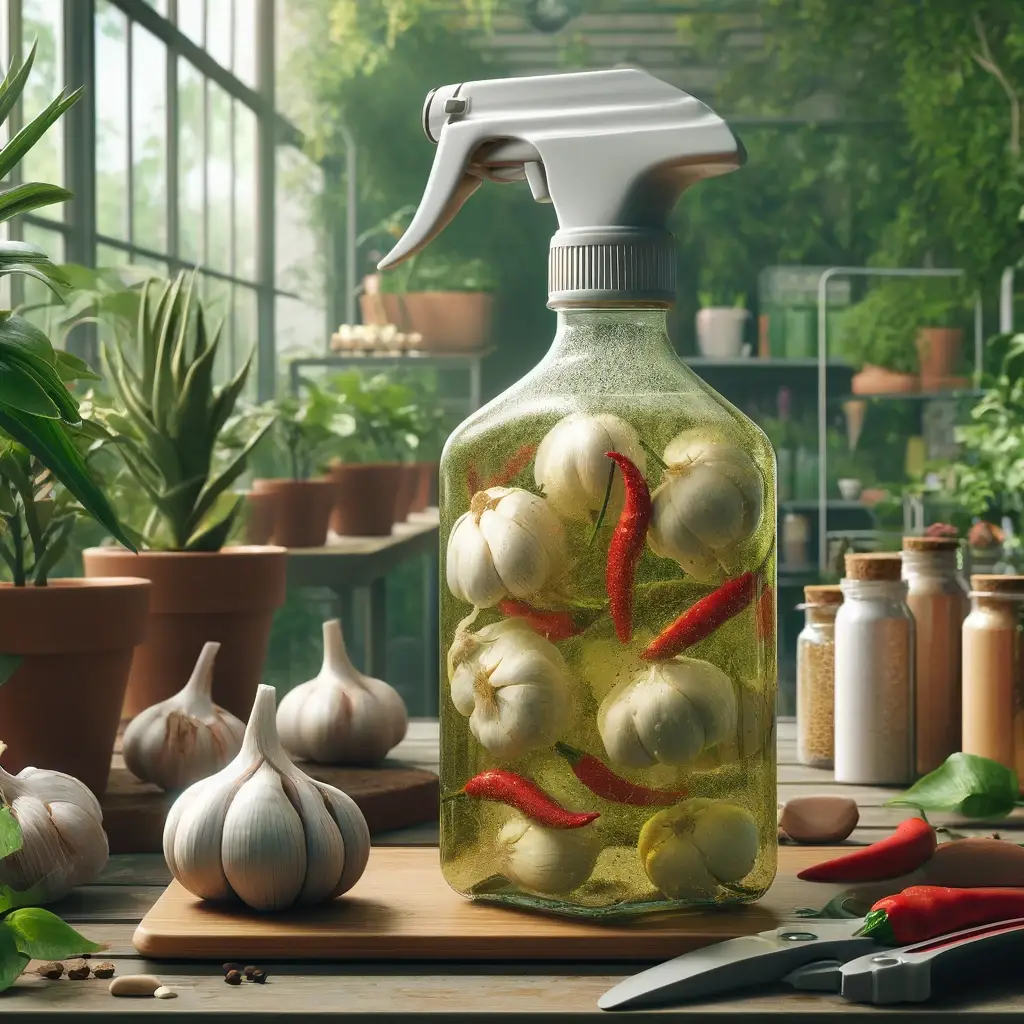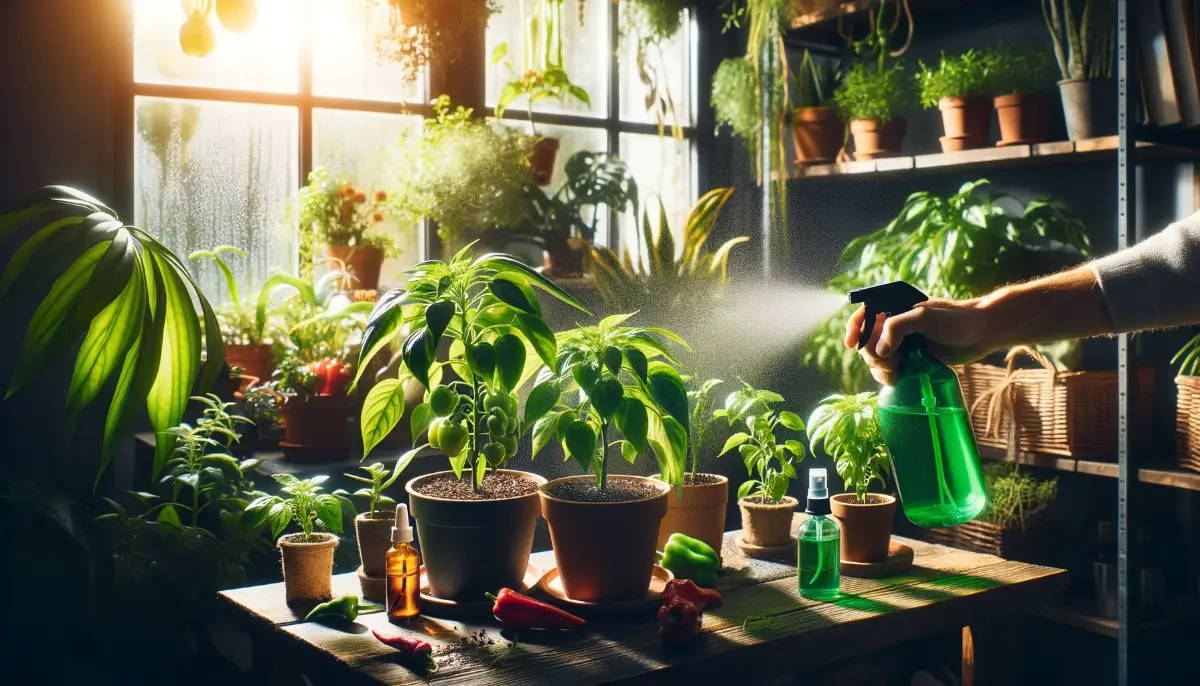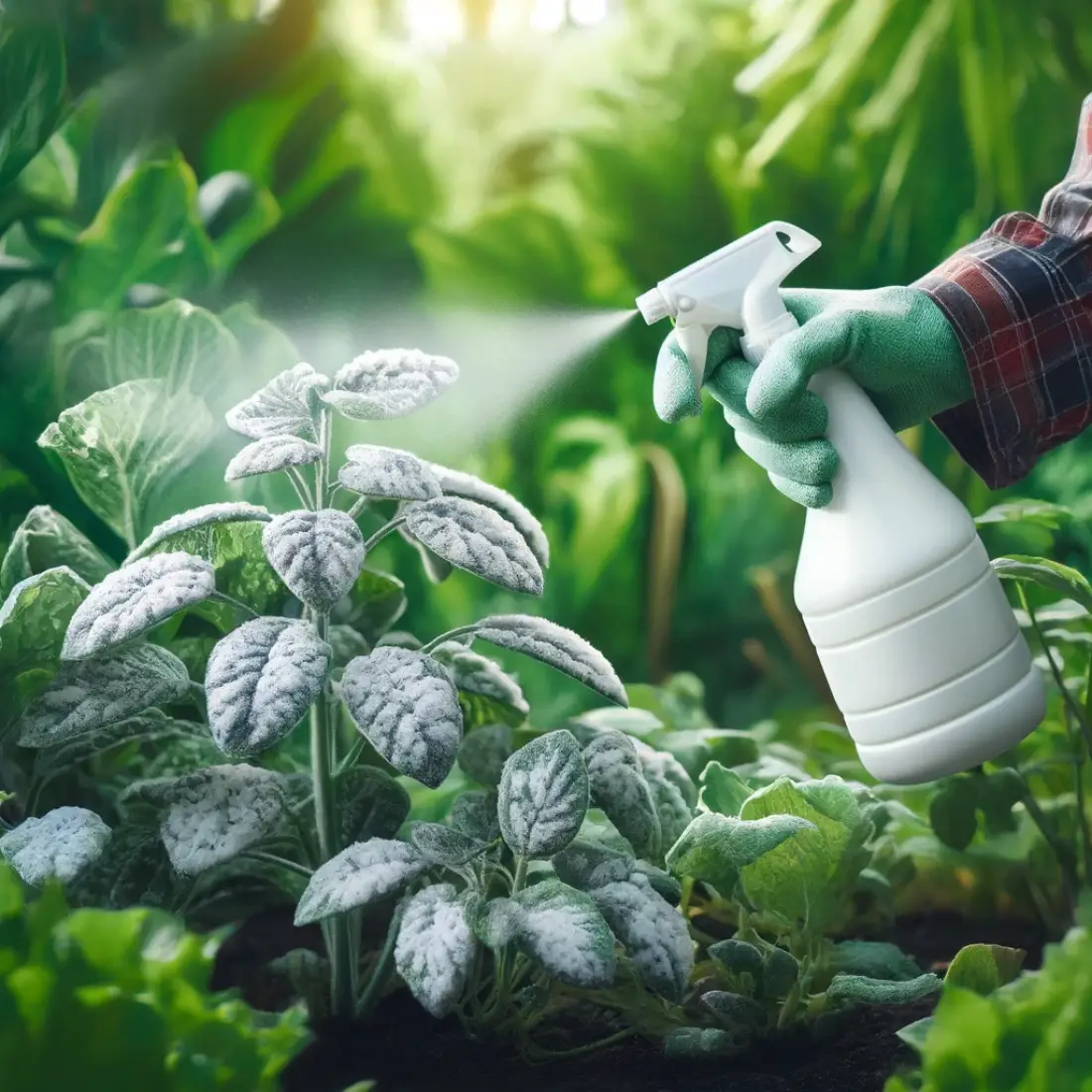Garlic and chili spray is a powerful, natural solution for managing pests and promoting plant health in an indoor garden.
This organic pesticide and mild nutrient booster combines the potent properties of garlic and chili peppers, offering a safe and eco-friendly alternative to chemical pesticides.
By leveraging the natural pest-repellent and antimicrobial characteristics of these ingredients, gardeners can protect their indoor plants from common pests without resorting to harmful chemicals.
Benefits of Using Organic Garlic and Chili Sprays
Environmentally Friendly: Organic sprays, such as garlic and chili spray, minimize the environmental impact by avoiding synthetic chemicals that can harm beneficial insects, soil health, and water quality. Using natural ingredients ensures that the ecosystem remains balanced and healthy.
Safe for Indoor Use: Organic sprays are non-toxic to humans and pets, making them ideal for indoor gardening. Unlike chemical pesticides, they do not leave harmful residues on plants, which is crucial for gardens in living spaces.
Effective Pest Control: Garlic and chili spray effectively repels a wide range of common indoor pests, including aphids, spider mites, and whiteflies. The combination of garlic’s sulfur compounds and chili peppers’ capsaicin creates a hostile environment for these pests, reducing infestations naturally.
Mild Nutrient Benefits: Besides pest control, the spray provides trace minerals and compounds that can mildly boost plant health. The sulfur in garlic and the nutrients in chili peppers can enhance the plant’s immune response and overall vitality.
Pest Control
Repelling Common Indoor Pests
- Aphids: Garlic and chili spray effectively deters aphids, which are small sap-sucking insects that can cause significant damage to indoor plants by stunting their growth and causing yellowing leaves.
- Spider Mites: These tiny arachnids can infest indoor plants, causing leaves to become speckled and discolored. The strong scent and compounds in garlic and chili repel spider mites, reducing their population.
- Whiteflies: Whiteflies are small, white, moth-like insects that feed on plant sap and can spread plant diseases. Garlic and chili spray helps in keeping these pests at bay by making the plants less attractive to them.
Antibacterial and Antifungal Properties
- Sulfur Compounds in Garlic: These compounds have natural antibacterial and antifungal properties that help in preventing and controlling plant diseases caused by bacteria and fungi.
- Capsaicin in Chili Peppers: Capsaicin acts as a natural pesticide and has antifungal properties, helping to protect plants from a variety of fungal infections.
Diseases Controlled by Garlic and Chili Spray
Powdery Mildew
- Symptoms: White, powdery spots on leaves and stems.
- Control: Regular application of garlic and chili spray can prevent and reduce powdery mildew by its antifungal properties.
Downy Mildew
- Symptoms: Yellow or white patches on the upper leaf surfaces and a downy growth on the underside.
- Control: Use the spray to treat affected areas, reducing the spread of this fungal disease.
Black Spot
- Symptoms: Black spots on leaves, leading to yellowing and drop-off.
- Control: Apply the spray to affected plants to manage and prevent further spread of the fungus.
Blight
- Symptoms: Brown or black lesions on leaves, stems, and fruit.
- Control: Regular spraying helps manage both early and late blight by its antifungal and antibacterial properties.
Rust
- Symptoms: Orange, yellow, or brown pustules on the undersides of leaves.
- Control: Garlic and chili spray can reduce rust severity by its antifungal action.
Leaf Spot
- Symptoms: Dark, water-soaked spots on leaves.
- Control: The antibacterial properties of garlic help control bacterial leaf spot diseases.
Anthracnose
- Symptoms: Dark, sunken lesions on leaves, stems, and fruit.
- Control: Spray affected areas to manage this fungal disease, preventing its spread.
Botrytis (Gray Mold)
- Symptoms: Gray, fuzzy mold on leaves, stems, and flowers.
- Control: The spray can help reduce mold growth by its antifungal properties.
Nutrient Boost
Trace Minerals and Compounds
- Garlic: Rich in sulfur, garlic provides essential trace minerals that are beneficial for plant growth and development. Sulfur is a vital nutrient that helps in the formation of proteins and enzymes in plants.
- Chili Peppers: Contain various nutrients, including vitamins A and C, which can contribute to the overall health of the plants. These nutrients can enhance the plant’s growth and resilience.
Enhancing Plant Immune Response
- Strengthening Plant Defenses: The compounds in garlic and chili help to strengthen the plant’s natural defenses against pests and diseases. This makes the plants more resilient and capable of withstanding pest attacks and environmental stressors.
- Improving Overall Health: Regular application of garlic and chili spray can improve the overall health and vigor of the plants, leading to better growth, increased flowering, and higher yields in fruiting plants.
Ingredients and Preparation
Required Ingredients:
Garlic Cloves
- Garlic contains sulfur compounds that have natural pesticidal and antifungal properties.
- Use about 1 bulb of garlic for a strong solution.
Chili Peppers (Fresh or Dried)
- Chili peppers contain capsaicin, which repels many pests.
- Use 2-3 fresh chili peppers or 1 tablespoon of chili powder.
Water
- Acts as the base for the spray solution.
- Use 1 liter of water.
Optional: Mild Soap
- Helps the mixture adhere to plant leaves and enhances the spray’s effectiveness.
- Use a few drops of mild soap.
Preparation Steps
Blending and Mixing
- Peeling and Crushing Garlic: peel 1 bulb of garlic and crush the cloves to release the active compounds.
- Chopping Chili Peppers: If using fresh chili peppers, chop them finely. If using chili powder, measure 1 tablespoon.
- Blending Ingredients: Combine the crushed garlic and chopped chili peppers (or chili powder) with 1 liter of water in a blender. Blend the mixture thoroughly until it is well combined.
Straining the Mixture
- Using a Fine Mesh Strainer or Cheesecloth: Strain the blended mixture through a fine mesh strainer or cheesecloth to remove solid particles. This step is crucial to prevent clogging of the spray bottle nozzle.
- Collecting the Liquid: Collect the strained liquid in a clean container, ensuring that it is free of any large particles.
Adding Mild Soap (Optional)
- Mixing Soap into the Solution: Add a few drops of mild soap to the strained liquid. The soap acts as an emulsifier, helping the spray stick to the plant leaves. Stir the mixture gently to combine the soap with the liquid.
Storage and Shelf Life
- Storing Leftover Spray: Store any leftover garlic and chili spray in a labeled container in the refrigerator. Use the stored spray within one week for best results.
Application Techniques for Garlic and Chili Spray
- Spray Bottle or Hand Sprayer: Use a clean spray bottle or hand sprayer to ensure even and thorough application.
- Fine Mesh Strainer or Cheesecloth: Essential for straining the mixture to prevent clogging the spray nozzle.
Best Practices for Application
Time of Day
- Early Morning or Late Afternoon: Apply the spray early in the morning or late in the afternoon to avoid leaf burn caused by direct sunlight. This also allows the plants to absorb the spray more effectively.
Environmental Conditions
- Calm, Cool Weather: Apply the spray during calm weather conditions to avoid drift and ensure the spray stays on the plants.
Application Frequency
- Regular Application: Apply the spray once a week or as needed based on pest activity. Increase frequency if there is a heavy infestation.
Coverage
- Even Coverage: Ensure thorough coverage on both the upper and lower surfaces of the leaves, where pests often hide and lay eggs.
Step-by-Step Application Process
Testing on a Small Area First
- Initial Test: Before applying the spray to the entire plant, test it on a small area of one plant to ensure there are no adverse reactions. Wait 24 hours to observe any negative effects.
Preparing the Solution
- Shake Well: Shake the spray bottle well before each use to ensure the ingredients are well mixed.
- Dilution: If necessary, dilute the mixture further if the initial concentration is too strong for the plants.
Spraying Evenly
- Application Technique: Hold the spray bottle about 6-12 inches away from the plant and spray evenly. Ensure both the top and bottom sides of the leaves are covered, as well as the stems and any visible pests.
- Avoid Over-Spraying: Do not over-saturate the leaves. A light misting is usually sufficient.
Monitoring Plant Response
- Observing Effects: After application, monitor the plants for any signs of stress, such as leaf discoloration or wilting. Adjust the concentration or frequency of application if adverse effects are observed.
- Reapplication: Reapply the spray weekly or as needed, especially after rain or watering that washes off the spray.
Cleaning the Equipment
- Rinse Spray Bottle: Rinse the spray bottle thoroughly after each use to prevent clogging and maintain the effectiveness of the spray.
Safety Precautions for Using Garlic and Chili Spray
- Wear gloves and eye protection to avoid irritation.
- Use a well-ventilated, clean space.
- Store in labeled containers in the refrigerator. Keep out of reach of children and pets.
- Follow recommended ratios and mix well.
- Apply early morning or late afternoon, not in direct sunlight.
- Test on a small area first. Observe for stress signs and adjust as needed.
- Apply lightly and clean the spray bottle regularly.
- Use leftover spray appropriately and compost solids.
- Use organic ingredients and dispose of unused spray responsibly.
FAQs on Using Garlic and Chili Spray for Indoor Gardens
What pests does garlic and chili spray repel?
Garlic and chili spray repels aphids, spider mites, whiteflies, and other common indoor pests.
Can I use garlic and chili spray on all indoor plants?
Yes, it is generally safe for most indoor plants, but always test on a small area first to ensure no adverse reactions.
How often should I apply garlic and chili spray?
Apply once a week or as needed, especially during high pest activity periods.
Can garlic and chili spray prevent plant diseases?
Yes, it can help prevent and control diseases such as powdery mildew, downy mildew, black spot, and rust due to its antifungal and antibacterial properties.
What are the main ingredients needed to make garlic and chili spray?
The main ingredients are garlic cloves, chili peppers (or chili powder), water, and optionally, a few drops of mild soap.
Is garlic and chili spray safe for pets and humans?
Yes, it is non-toxic and safe for use around pets and humans, but avoid direct contact with skin and eyes during preparation and application.
Can I store leftover garlic and chili spray?
Yes, store it in a labeled container in the refrigerator for up to one week.
How do I prevent leaf burn when using the spray?
Apply the spray in the early morning or late afternoon and avoid direct sunlight to prevent leaf burn.
What should I do if I see signs of plant stress after application?
Reduce the concentration of the spray or frequency of application if you notice leaf discoloration, wilting, or burn marks.
Can garlic and chili spray be combined with other organic treatments?
Yes, it can be used alongside other organic treatments like compost tea or neem oil, but always test compatibility on a small area first.









